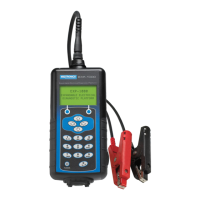• 20 •
5. Press the UP/DOWN ARROW keys or use the numeric keys to select the
RATING UNITS or in the case of JIS, the part number. To increase your
scrolling speed, hold down the UP or DOWN ARROW key.
The default selection is 500 for all rating standards except JIS, which consists of part
numbers. The entry range is 100 to 3000 except for DIN and IEC, which has a range of
100 to 1000. If you scroll the values they increase and decrease by 5 units.
Press the NEXT soft key to start the test.
For the next few seconds the EXP will display the word TESTING and a stopwatch while
it evaluates the battery. The analyzer will also display your selected rating standard and
units or JIS part number.
Additional Test Requirements
For a more decisive result the EXP may ask for additional information or probe deeper into the
battery’s condition. The following messages and instructions may appear before the analyzer displays
the results of your test.
Temperature Compensation
Surface Noise/Unstable Battery
The battery will hold a surface charge if the engine has been running or after the battery has been
charged. The analyzer may prompt you to remove the surface charge before it begins testing.
1. Follow the EXP’s instructions indicating when to turn the headlights on and off.
2. The analyzer will resume testing after it detects that the surface charge is removed.
If the analyzer detects that the temperature of the battery
may make a difference in the result, it will ask you to
measure the battery’s temperature with the analyzer’s
built-in temperature sensor.
The sensor is located in the top left corner of the EXP.
An arrow moving diagonally across the display will show
you how to angle the EXP so that the sensor is pointed
directly at the battery.
Press the NEXT soft key to continue.
Figure 11: Temperature Message
Battery Case
(Top)
Sensor
Aim the EXP
2 inches (5 cm)
from the sides
or top of the
battery case.
Figure 12:
Aiming the Temperature Sensor
Chapter 4: Battery Test

